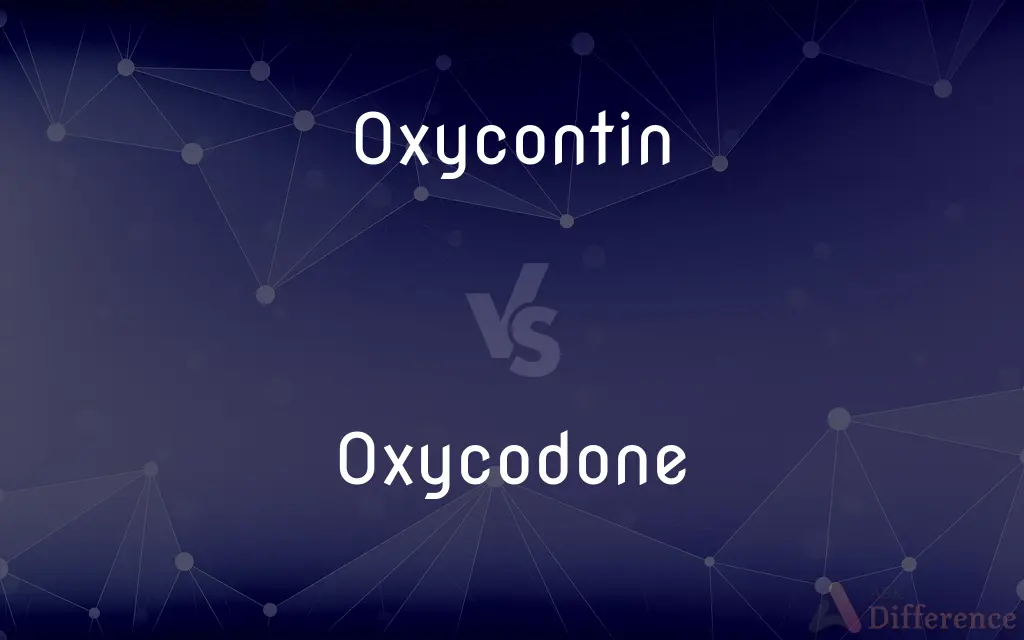Oxycontin vs. Oxycodone — What's the Difference?
By Tayyaba Rehman — Updated on September 22, 2023
Oxycontin is a brand-name, extended-release form of the painkiller oxycodone, while oxycodone is a generic opioid analgesic.

Difference Between Oxycontin and Oxycodone
Table of Contents
ADVERTISEMENT
Key Differences
Oxycontin and oxycodone are both medications prescribed for pain relief, but they have key distinctions. Oxycontin is a brand name, representing a specific formulation of oxycodone designed for extended release. This means that Oxycontin provides pain relief over a longer duration, usually 12 hours. Conversely, oxycodone refers to the active ingredient present in several pain relief medications, including Oxycontin.
Oxycontin's extended-release formulation ensures that patients experience consistent pain relief without needing frequent doses. Oxycodone, when not in the Oxycontin formulation, typically comes in immediate-release forms, requiring more frequent dosing to achieve the same level of relief. Both medications, being opioids, function by binding to opioid receptors in the brain, reducing the perception of pain.
Due to their opioid nature, both Oxycontin and oxycodone have potential for misuse and addiction. While Oxycontin's extended-release nature aims to provide prolonged pain relief, misuse, such as crushing the pills, can lead to a rapid release of oxycodone, increasing overdose risks. Similarly, oxycodone, especially in its immediate-release forms, can be misused, leading to respiratory depression and other complications.
Patients and healthcare providers should be aware of the differences between Oxycontin and oxycodone. Oxycontin is specifically designed for chronic pain management and should be prescribed and used accordingly. On the other hand, oxycodone in its various forms can be used for both acute and chronic pain, with the dosage and frequency adjusted based on the specific formulation and patient needs.
Comparison Chart
Nature
Brand name
Generic drug
ADVERTISEMENT
Release Mechanism
Extended-release
Typically immediate-release
Usage
Primarily for chronic pain
Both acute and chronic pain
Potential for Misuse
High, especially if tablets are altered
High, especially with frequent dosing
Active Ingredient
Contains oxycodone as the active ingredient
Is the active ingredient in many painkillers
Compare with Definitions
Oxycontin
Contains the opioid oxycodone as its primary ingredient.
Oxycontin is one of the popular medications containing oxycodone.
Oxycodone
A generic opioid pain reliever.
Doctors may prescribe oxycodone for post-operative pain.
Oxycontin
Has potential for misuse and addiction.
Misusing Oxycontin, like crushing the tablets, can be dangerous.
Oxycodone
Works by binding to opioid receptors in the brain.
Oxycodone reduces pain sensations by affecting neurotransmission.
Oxycontin
An opioid analgesic designed for 12-hour pain relief.
Oxycontin helps patients manage pain without frequent dosing.
Oxycodone
Available in both immediate and extended-release formulations.
Patients might take immediate-release oxycodone for sudden pain episodes.
Oxycontin
Specifically formulated for chronic pain management.
After her surgery, Jane switched from immediate-release painkillers to Oxycontin.
Oxycodone
Can lead to addiction if misused.
Regular misuse of oxycodone can result in opioid dependence.
Oxycontin
A brand-name painkiller with extended-release oxycodone.
John was prescribed Oxycontin for his chronic back pain.
Oxycodone
The active ingredient in several pain relief medications.
Some over-the-counter painkillers contain oxycodone.
Oxycodone
Oxycodone, sold under the brand names Roxicodone and OxyContin (which is the extended release form) among others, is an opioid medication used for treatment of moderate to severe pain. It is highly addictive and is commonly used recreationally by people who have an opioid use disorder.
Oxycodone
A semisynthetic opioid drug, C18H21NO4, used in its hydrochloride form as a pain reliever, often in combination with nonopioid analgesics such as acetaminophen.
Oxycodone
(pharmaceutical drug) A synthetic analgesic drug (trademark OxyContin) that is similar to morphine in its effects.
Common Curiosities
What is Oxycontin?
Oxycontin is a brand-name painkiller with extended-release oxycodone.
Why is Oxycontin's misuse potentially dangerous?
Misusing Oxycontin, like crushing the tablets, can lead to rapid oxycodone release and overdose.
Are both Oxycontin and oxycodone opioids?
Yes, both are opioid analgesics.
How often do patients typically take Oxycontin?
Oxycontin is usually taken every 12 hours for consistent pain relief.
Can patients become addicted to Oxycontin?
Yes, Oxycontin, like other opioids, has potential for misuse and addiction.
What risks are associated with oxycodone use?
Oxycodone has potential for misuse, addiction, and can lead to respiratory depression if overdosed.
How does Oxycontin provide extended pain relief?
Oxycontin is formulated to release oxycodone slowly over a 12-hour period.
What's the main ingredient in Oxycontin?
Oxycodone is the primary active ingredient in Oxycontin.
Can oxycodone be found in medications other than Oxycontin?
Yes, oxycodone is the active ingredient in several pain relief medications.
Is there a risk of overdose with oxycodone?
Yes, taking too much oxycodone can result in an overdose, leading to respiratory depression and other complications.
Is oxycodone the same as Oxycontin?
No, Oxycontin is a specific brand containing oxycodone in an extended-release form.
Which drug is more suited for acute pain, Oxycontin or oxycodone?
Immediate-release oxycodone formulations are often preferred for acute pain.
Why are opioids like Oxycontin and oxycodone prescribed cautiously?
Due to their high potential for misuse, addiction, and associated risks.
How do opioids like oxycodone work?
They bind to opioid receptors in the brain, reducing pain perception.
Can Oxycontin and oxycodone interact with other medications?
Yes, they can interact with other drugs, especially depressants, which can increase overdose risks.
Share Your Discovery

Previous Comparison
Dating vs. Engagement
Next Comparison
Luxury vs. NecessityAuthor Spotlight
Written by
Tayyaba RehmanTayyaba Rehman is a distinguished writer, currently serving as a primary contributor to askdifference.com. As a researcher in semantics and etymology, Tayyaba's passion for the complexity of languages and their distinctions has found a perfect home on the platform. Tayyaba delves into the intricacies of language, distinguishing between commonly confused words and phrases, thereby providing clarity for readers worldwide.














































